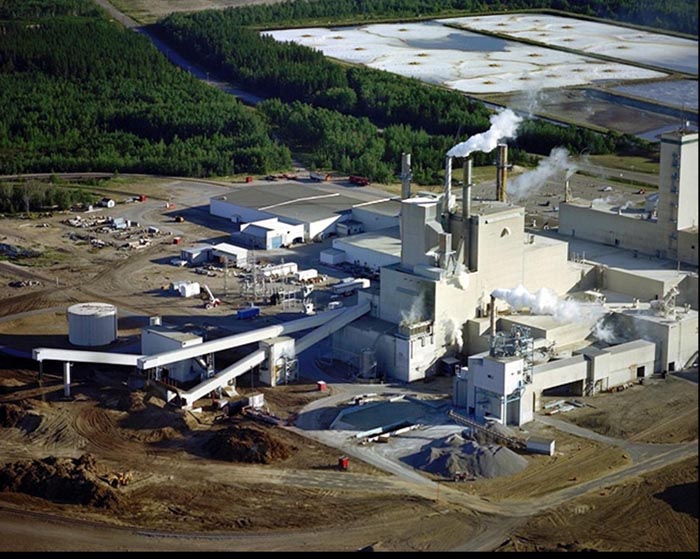
Features
Environment & Sustainability
Paper
Pulp
Editorial: ‘Net-zero’ will involve building new processes, optimizing old ones
February 23, 2021 By Kristina Urquhart
 Resolute's Saint-Félicien, Quebec pulp mill has a cogeneration facility. Photo: © Resolute Forest Products
Resolute's Saint-Félicien, Quebec pulp mill has a cogeneration facility. Photo: © Resolute Forest Products Canada plans to reach net-zero carbon emissions by 2050 – so what lies ahead for the pulp and paper industry?
Last November, the federal government tabled a bill to establish the Canadian Net-Zero Emissions Accountability Act, which would appoint an advisory body to set rolling five-year emissions-reductions targets, as well as strategies to reach and report on each target. The legislation mentions “sectoral strategies,” so, should the bill pass, we can assume that there will be specific instruction forthcoming for the pulp and paper industry.
What we do know is in order for greenhouse gas (GHG)–producing heavy industries such as pulp and paper to reach “net-zero,” they’ll have to completely offset their GHG emissions by capturing carbon before it reaches the air.
This industry has made major improvements to capture carbon over the last 30 years, reducing its GHG emissions by 70 per cent since 1990 through processes such as electrification and cogeneration.
Plants are already making and using their own electricity as a way to reduce their emissions. Some (including Resolute’s Saint-Félicien mill, pictured above) have established cogeneration facilities, which use steam turbines or reciprocating engines to turn waste from one process into energy for another, such as heating or cooling. FPInnovations estimates that 60 per cent of fuel used in the pulp and paper industry is provided by biomass.
But fossil fuels are still a significant component of many processes. With pulp and paper, iron and steel, mining, refining and smelting, and cement accounting for over 75 per cent of Canada’s total industrial energy use, large industrial emitters will be a major focus of the government’s net-zero plan.
Much of this industrial energy is required for heating processes, drying and steam generation – and because pulping and papermaking use so much heat, it’s difficult to further reduce the amount of energy used.
A “mid-century strategy” report submitted to the United Nations by Environment and Climate Change Canada after the 2016 signing of the Paris Agreement offers suggestions for decarbonization in heavy industry, but also recognizes the challenges that lie therein, including international trade competition, global market prices that affect cost of production, and the level of government investment that is required to make more environmentally responsible processes financially viable.
The report says that process optimization will play a key role in emissions reductions, from operations and control improvements, to regular maintenance, to upgrades for heating, cooling and power production and recovery.
The sector will need to explore new processes, such as carbon capture and storage systems and fuel-switching, and reimagine old ones to reduce energy – for example, by drying paper with chemical additives to reduce heat consumption, or by recycling recovered paper.
With those solutions, though, new sets of challenges arise – like the proper reuse or disposal of chemicals, or the fact that paper can only be re-pulped so many times before the fibres are too short for re-use.
Regardless, the feds’ proposed plan means low-carbon fuels, increased recycling and changes to existing processes are on the horizon. So we’re pleased to present a number of ways to improve processes in the Winter 2021 issue of Pulp & Paper Canada, starting with the first technical paper in a three-part series on industrial cogeneration from Natural Resources Canada’s clean-tech research firm CanmetENERGY, which covers optimization at the supervisory level for steam plants (p. 18). We’ll publish the next two papers in two upcoming issues.
Further downstream, we’re exploring the new ways that process analyzers use near-infrared spectroscopy to improve process control in chemical recovery, chlorine dioxide generation and digesting with FPInnovations and FT-NIR (p. 10 and p. 16). And, if you’re looking for ways to save human energy, we talked to Project: Recapture on p. 24 about their new software that promises to streamline oversight on maintenance contract billing.
Continuous improvement is something pulp and paper producers do on a daily basis. No matter what comes next with the net-zero plan, this is an industry that has adapted before – and it’ll do so again.
A condensed version of this article appears in the Winter 2021 issue of Pulp & Paper Canada.
Print this page